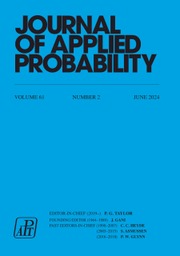Article contents
A Geometric Drift Inequality for a Reflected Fractional Brownian Motion Process on the Positive Orthant
Published online by Cambridge University Press: 14 July 2016
Abstract
We study a d-dimensional reflected fractional Brownian motion (RFBM) process on the positive orthant S = ℝ+ d , with drift r 0 ∈ ℝ d and Hurst parameter H ∈ (½, 1). Under a natural stability condition on the drift vector r 0 and reflection directions, we establish a geometric drift towards a compact set for the 1-skeleton chain Ž̆ of the RFBM process Z; that is, there exist β, b ∈ (0, ∞) and a compact set C ⊂ S such that ΔV(x):= E x [V(Ž̆(1))] − V(x) ≤ −βV(x) + b 1 C (x), x ∈ S, for an exponentially growing Lyapunov function V : S → [1, ∞). For a wide class of Markov processes, such a drift inequality is known as a necessary and sufficient condition for exponential ergodicity. Indeed, similar drift inequalities have been established for reflected processes driven by standard Brownian motions, and our result can be viewed as their fractional Brownian motion counterpart. We also establish that the return times to the set C itself are geometrically bounded. Motivation for this study is that RFBM appears as a limiting workload process for fluid queueing network models fed by a large number of heavy-tailed ON/OFF sources in heavy traffic.
Keywords
- Type
- Research Papers
- Information
- Copyright
- Copyright © Applied Probability Trust 2011
References
- 2
- Cited by


